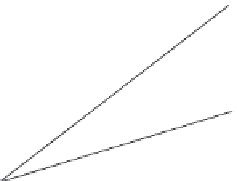Geoscience Reference
In-Depth Information
could be successfully handled exhibited a steeper relationship with body
size than the smallest, meaning larger predators had a wider potential
diet breadth than smaller ones (
Figure 5
A). Further, larger predators
incurred reduced costs when preying on larger, more nutritious prey com-
pared to smaller predators; thus, changing the relative profitabilities of
different resource items for different sized consumers (
Figure 5
B) (
Brose
et al., 2006; Petchey et al., 2008
). In all these studies, the requirements
associated with greater body size are met by the allometric scaling of energy
availability, and hence the allometric scaling of trophic level (
Sole and
Montoya, 2001
).
C. The Structure of Host-Parasitoid Networks
Due to the way in which parasitoids interact with their hosts, the relationship
between body-size distributions and host-parasitoid network structure is less
obvious than in food webs. However, as we argue, size-based foraging
decisions can be an important structuring force in these networks but depend
strongly upon species life history. The next section discusses how the funda-
mental niche of a parasitoid is determined by its evolutionary history. Then
we discuss the manner in which parasitoid traits determine realised niche.
A
B
Maximum prey size
Small predator
Diet breadth
Large predator
Minimum prey size
Predator size
Prey size
Figure 5
Illustrations of how body size is thought to determine network structure in
food webs; as suggested in
Petchey et al. (2008)
. (A) Diet breadth, in terms of the size
of available prey, increases with predator size because the size of the largest prey
resource that can be handled successfully scales faster than the size of the smallest. (B)
The cost associated with handling resource items increases with the size of the
resource item, which is proportional to its nutritional value; however, handling
costs covary with consumer size in such a way that larger predators incur smaller
costs from handling larger prey items than smaller predators. In a recent extension of
the model,
Woodward et al. (2010a)
found that the accuracy with which network
structure could be predicted by the ADBM increased markedly when size classes of
individuals, irrespective of species identity, were used in a range of aquatic food webs,
highlighting the overarching effect of size versus taxomonic identity in these systems.










